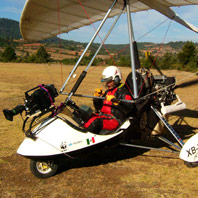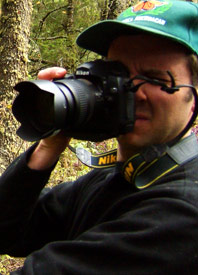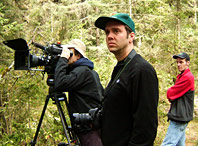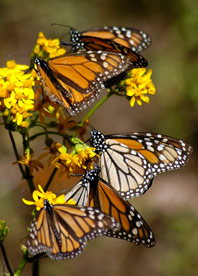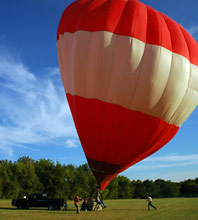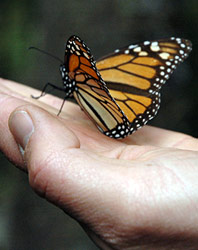The Director's Story:
Chasing Butterflies
For most of his career, director and cinematographer Nick de
Pencier was more interested in filming artists and dancers
than wild animals. A few years ago, however, he set out to
pursue monarch butterflies. In this interview, learn why the
monarchs' story—and the adventure of filming
them—captivated him.
A HERCULEAN JOURNEY
Q: What compelled you to make a film about monarchs?
Nick de Pencier: They're a big part of the collective
psyche, I think, all over North America, but certainly where I
was from. I grew up on Toronto Island, which is on Lake
Ontario. My childhood was full of images of these creatures,
and of metamorphosis, so that seed was planted early.
The specific idea for the documentary came from reading Sue
Halpern's book [Four Wings and a Prayer: Caught in the Mystery of the
Monarch Butterfly]. It's a story that, in some ways, is pretty
arcane—the story of just one insect, but it's so
well-written and the characters are so rich that it resonates
with universal struggles. I wanted to tell that kind of story
with the film.
Q: Do you have memories of watching monarchs in your
backyard as a kid?
de Pencier: Yes, exactly. As a kid, you see this
butterfly just in your own backyard, and you know that it
flies away, but you don't know where it goes. Making the
documentary, I met lots of people who have equivalent local
stories. By following the monarchs, I was able to get a
panoramic view of this incredible Herculean journey and how we
are all connected to it.
Q: Did you actually take the journey of the monarchs
yourself?
de Pencier: I did. After the shooting the first year,
which we did with a big crew, we realized that we didn't have
the whole story. So then I went out—just me and a camera
in an RV—and I drove through all the states,
consecutively, right down to Mexico and camped in the
mountains.
Q: Did you ever think about focusing on just one
butterfly's journey?
de Pencier: Obviously, we couldn't follow one
butterfly all the way. That would have been impossible. In
drafting the original script, we thought of trying to tell the
story through the struggle of one butterfly. But we realized
that wasn't important.
Some natural history films, like Meerkat Manor and
others that successfully anthropomorphize animals, have a lot
more to work with. Monarchs aren't exactly primates. They are
such small animals. Yet it was essential that viewers could
see the butterfly as having the characteristics you need for
drama, which I truly believe it has. It has the perseverance
to go on this journey, against all odds, with a kind of
heroism.
Q: Maybe what captivates people watching the film is
the almost mythic, magical quality of the migration, rather
than identifying with one particular butterfly.
de Pencier: Yeah, that is what we discovered.
MIGRATING TO MEXICO
Q: It astounded me that the extent of the migration
wasn't understood until fairly recently.
de Pencier: Yes. It was a big mystery that was solved
by citizen-scientists and the tagging programs. Eventually,
enough tags were recovered that they were able to understand
the migration patterns and where the butterflies went.
Obviously, the locals in the Sierra Madre mountains in Mexico
have known for centuries about the monarchs' over-wintering
sites, but science didn't discover them until the 1970s. It
was a National Geographic article that really broke the
story.
Q: So even in the 1960s, scientists in North America
were aware of monarchs in specific locations, but they didn't
know where they were going?
de Pencier: They didn't. The sites in Mexico are
extremely remote, far off the beaten track, and they're at
high altitudes. There aren't a lot of reasons to go to those
places if you're not looking for butterflies.
"Their ability to navigate relative to the size of their
brains is astounding."
Q: Watching the film, I felt like I was flying along
with the butterflies. How did you do the aerial shooting?
de Pencier: At the beginning, I wanted to use a very
expensive camera mount on a helicopter called a Wescam. We
could only afford one day with it, which meant that we
couldn't get all the representative landscapes between Canada
and Mexico from the air. But we had a spectacular day and a
great pilot, and I think the footage really does elevate you.
Later on, though, I discovered that, in fact, a
hot-air-balloon ride is a much closer approximation of the
speed and the way that butterflies fly. We did a few of those,
and if I could do it all again, I probably would forgo the
super-expensive helicopter day for 10 or 15 balloon rides.
We also had a wonderful ultralight flyer, which we used to
shoot aerials right in the Sierra Madre Mountains.
Q: When you were in the mountains in the ultralight,
were there butterflies right around you?
de Pencier: There were some fairly close to us, but
they don't really appear in the footage because we were flying
faster than they do. We certainly didn't want to fly right
into a big cluster of them.
Q: In some shots, closer to the ground, it seems like
the camera is one of the butterflies, flying with them. Was
that hard to capture?
de Pencier: It was. It's hard to get their typical
flight because the French DP [Director of Photography] or I
had to basically run along beside the butterflies with the
camera for a short period of time, so they tend to go into
more of an evasive flight than a cruising or gliding flight.
Q: I didn't realize they were flying away from you!
de Pencier: Pretty much.
EUPHORIA
Q: Of all the challenges, what was the trickiest
moment in the film to capture?
de Pencier: The biggest gamble, with the highest
stakes, was the one day that we were allowed up into the
sanctuary in Mexico, where you are not technically allowed for
non-scientific purposes. We made the case that, if we were
extremely sensitive and went with the scientists and the local
guardians to make sure that we were not overstepping bounds,
the benefit of raising awareness about the monarchs would
outweigh any downside to us being there on that one day.
So we had to struggle to get there—bureaucratically and
physically. We were lugging up a lot of equipment. We had a
30-foot jib arm to put the camera on to film the clusters of
monarchs high in the trees as well as lots of other gear.
We went towards the end of March, when the butterflies are
still in their winter mode. It is still very cold at night,
and they are just hanging on the trees in suspended animation.
It could have been raining, so many other things might have
gone wrong, but we got exactly what we wanted in terms of
butterflies in their dormant winter state. And it was the time
of year when the sun is starting to give enough radiation
during the day that they can warm up their wings and start to
fly around. We had a beautiful sunny day, and the sun warmed
up the whole sanctuary. So we didn't just get the shots of
them hanging motionless, we got them flying by the millions
and millions.
Q: The film also shows the butterflies arriving, so I
assumed you filmed in the sanctuary multiple times.
de Pencier: We had filmed lower down, not in the
sanctuary itself, in October-November, around the Day of the
Dead, when the monarchs begin to arrive. They arrive over the
course of about a month. Eventually, they all gather higher in
the sanctuary on just a handful of mountaintops. The
aggregations we saw in October were amazingly impressive, but
nothing like the numbers we saw later.
In March, we were at the center of the biggest colony of that
year. Personally standing there, you cannot help but be moved,
and it really hit home for me how important it is to tell this
story. With millions of butterflies flying around us, it was a
feeling of euphoria that is indescribable.
Q: At that point you also had been invested in the
project for many months.
de Pencier: Exactly. In a way, it was the payoff for
all those efforts. And it was the end of the journey. It's
amazing how parallel the journey of the film was to the
journey of the butterflies—with tons of challenges and
pitfalls and zingers and everything along the way. So that
really was the climax moment. It was a moment I will never
forget.
WORTH THE WAIT
Q: I want to jump back to the beginning of this
incredible journey. Was it hard to film the caterpillar first
hatching from its egg, and then the butterfly emerging from
the chrysalis? How do you plan for that?
de Pencier: It's funny, in the few years since I shot
that, cameras have changed. They now have something called
picture cache, where you can basically press "record" and have
the previous six seconds of time recorded. If I had had that
when I shot the metamorphosis, I would have added years to my
own life span. I spent so many hours tensely waiting, not
wanting to miss the key moments.
We would have two or three chrysalises set up, well-lit for
filming. But there are tons of false starts, and I have swaths
of blank HD cam tape where I thought it was about to happen. I
spent sleepless nights trying to capture it.
Q: So there aren't clear signs of when a butterfly
will emerge?
de Pencier: Well, the beautiful emerald-green
chrysalis does become less opaque, and you can start to see
the black and orange through the outer casing—that's a
tip-off that it will happen within about a day. But all I
could do was have 10 or a dozen in that situation and just
basically stare at them.
"The only way they survive is through this magical process."
Q: Once the butterfly begins emerging, does it happen
quickly?
de Pencier: It's very quick—a matter of minutes.
Then they pump fluid into their wings, and within an hour the
wings have dried and the butterflies are ready for flight.
Q: Given all the waiting and the false starts, how did
it feel to actually film the birth of the butterfly?
de Pencier: That's another magic moment. I had a
privileged view of a pretty spectacular phenomenon.
Q: Any other special moments?
de Pencier: Some of my favorite production moments
were when we had a butterfly tent in our backyard and I had
time-lapse cameras set up in the basement for metamorphosis. I
have two young kids who were ecstatic to have our house
co-opted for butterflies.
Q: So your kids will have childhood memories filled
with butterflies, too.
de Pencier: They will.
MYSTERIES AND DANGERS
Q: I'm awed that these little creatures can fly 50
miles a day and even more. What do you think is the most
amazing thing about monarchs?
de Pencier: For me, it's the navigation. They can be
blown way off course, and scientists have Fed-Exed them across
10 states, east to west, and after a day or two they will get
back on the right course towards Mexico. They have built-in
compasses, somehow. We really don't know how. And just like
planes and boats, they often have to compensate for different
wind directions. Their ability to navigate relative to the
size of their brains is astounding.
Q: You follow them in the film as they cross the Great
Lakes. How important is it that they have resting places on
boats?
de Pencier: They certainly can make it without boats,
but there were Great Lake sailors who told us about their
boats suddenly being covered in a blanket of monarchs, so they
are obviously happy for the rest. And they are smart enough to
wait for favorable winds to give them a better chance of
crossing the lakes.
Q: Do they have a hard time going through urban areas?
de Pencier: Since they are such opportunistic feeders,
they are well-adapted. The caterpillar can only survive on
milkweed, but the adult butterfly can drink nectar from any
flower. So that helps them all a lot. What doesn't help them,
I am sure, is the amount of land that is being turned into
parking lots. But lots of people plant butterfly gardens, and
anyone with a flower garden is helping.
I loved going down in the first week or two in September, with
my camera, right among the skyscrapers of downtown Toronto and
looking up. No one else is looking up, but if you do there are
a thousand monarchs.
Q: Lincoln Brower, one of the experts in the film,
says that their migration—how they know where to
go—is still pretty mysterious.
de Pencier: I think it's part of the nature of science
that there always have to be mysteries.
Q: Is it true that there are other monarchs in the
world that don't migrate?
de Pencier: That's right.
Q: Where are they?
de Pencier: There are quite a few populations. That's
why the migration, if it were to be compromised and the whole
population that relies on it to exist were to
collapse—which is a very real possibility—it would
not be the end of this species. So we are not talking about a
species in danger of becoming extinct globally, but it is an
endangered phenomenon.
There are monarch populations west of the Rockies that migrate
to California, a much smaller migration. There are a bunch of
tropical populations that are non-migratory. There is a group
in Florida that doesn't migrate, and there are monarch
butterflies in Spain and outlier populations even in the South
Pacific. But the greatest population, by far, blankets North
America east of the Rockies for all the warm months and then
migrates to this tiny area in Mexico for the winter. The only
way they survive is through this magical process.
Q: In the film, you ask Lincoln Brower "What
difference would it make if we lost the monarch migration?" He
compares it to losing the Mona Lisa. Now that you have
spent so much time with these creatures, what would it mean to
you if the migration disappeared?
de Pencier: There is good change in the world, and bad
change. The collapse of the monarch migration, both in terms
of the particular loss and in terms of what it would represent
about where the planet is going, would be devastating.

